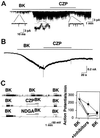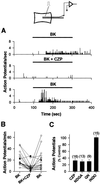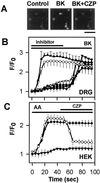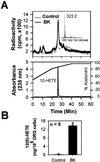Bradykinin-12-lipoxygenase-VR1 signaling pathway for inflammatory hyperalgesia
- PMID: 12097645
- PMCID: PMC126639
- DOI: 10.1073/pnas.152002699
Bradykinin-12-lipoxygenase-VR1 signaling pathway for inflammatory hyperalgesia
Abstract
The capsaicin-sensitive vanilloid receptor (VR1) was recently shown to play an important role in inflammatory pain (hyperalgesia), but the underlying mechanism is unknown. We hypothesized that pain-producing inflammatory mediators activate capsaicin receptors by inducing the production of fatty acid agonists of VR1. This study demonstrates that bradykinin, acting at B2 bradykinin receptors, excites sensory nerve endings by activating capsaicin receptors via production of 12-lipoxygenase metabolites of arachidonic acid. This finding identifies a mechanism that might be targeted in the development of new therapeutic strategies for the treatment of inflammatory pain.
Figures







Similar articles
-
Cardiac vanilloid receptor 1-expressing afferent nerves and their role in the cardiogenic sympathetic reflex in rats.J Physiol. 2003 Sep 1;551(Pt 2):515-23. doi: 10.1113/jphysiol.2003.048207. Epub 2003 Jun 26. J Physiol. 2003. PMID: 12829722 Free PMC article.
-
The cloned capsaicin receptor integrates multiple pain-producing stimuli.Neuron. 1998 Sep;21(3):531-43. doi: 10.1016/s0896-6273(00)80564-4. Neuron. 1998. PMID: 9768840
-
Sensitization of vanilloid receptor 1 induced by bradykinin via the activation of second messenger signaling cascades in rat primary afferent neurons.Eur J Pharmacol. 2004 Sep 13;498(1-3):37-43. doi: 10.1016/j.ejphar.2004.07.076. Eur J Pharmacol. 2004. PMID: 15363973
-
Nociceptor excitation by thermal sensitization--a hypothesis.Prog Brain Res. 2000;129:39-50. doi: 10.1016/S0079-6123(00)29004-3. Prog Brain Res. 2000. PMID: 11098680 Review. No abstract available.
-
Kinins and their receptors in hyperalgesia.Can J Physiol Pharmacol. 1997 Jun;75(6):704-12. Can J Physiol Pharmacol. 1997. PMID: 9276152 Review.
Cited by
-
Resilience to capsaicin-induced mitochondrial damage in trigeminal ganglion neurons.Mol Pain. 2020 Jan-Dec;16:1744806920960856. doi: 10.1177/1744806920960856. Mol Pain. 2020. PMID: 32985330 Free PMC article.
-
TRPV1 splice variants: structure and function.Front Biosci (Landmark Ed). 2010 Jun 1;15(3):872-82. doi: 10.2741/3651. Front Biosci (Landmark Ed). 2010. PMID: 20515731 Free PMC article. Review.
-
TRPV1 mediates histamine-induced itching via the activation of phospholipase A2 and 12-lipoxygenase.J Neurosci. 2007 Feb 28;27(9):2331-7. doi: 10.1523/JNEUROSCI.4643-06.2007. J Neurosci. 2007. PMID: 17329430 Free PMC article.
-
Intradermal administration of magnesium sulphate and magnesium chloride produces hypesthesia to mechanical but hyperalgesia to heat stimuli in humans.J Neuroinflammation. 2009 Aug 28;6:25. doi: 10.1186/1742-2094-6-25. J Neuroinflammation. 2009. PMID: 19715604 Free PMC article. Clinical Trial.
-
Neuroprotection by the endogenous cannabinoid anandamide and arvanil against in vivo excitotoxicity in the rat: role of vanilloid receptors and lipoxygenases.J Neurosci. 2003 May 15;23(10):4127-33. doi: 10.1523/JNEUROSCI.23-10-04127.2003. J Neurosci. 2003. PMID: 12764100 Free PMC article.
References
-
- Caterina M J, Schumacher M A, Tominaga M, Rosen T A, Levine J D, Julius D. Nature (London) 1997;389:816–824. - PubMed
-
- Tominaga M, Caterina M J, Malmberg A B, Rosen T A, Gilbert H, Skinner K, Raumann B E, Basbaum A I, Julius D. Neuron. 1998;21:531–543. - PubMed
-
- Caterina M J, Leffler A, Malmberg A B, Martin W J, Trafton J, Petersen-Zeitz K R, Koltzenburg M, Basbaum A I, Julius D. Science. 2000;288:306–313. - PubMed
-
- Davis J B, Gray J, Gunthorpe M J, Hatcher J P, Davey P T, Overend P, Harries M H, Latcham J, Clapham C, Atkinson K, et al. Nature (London) 2000;405:183–187. - PubMed
Publication types
MeSH terms
Substances
Grants and funding
LinkOut - more resources
Full Text Sources
Other Literature Sources
Medical

